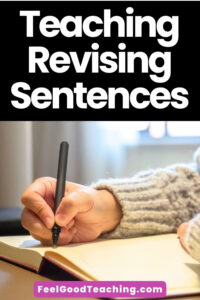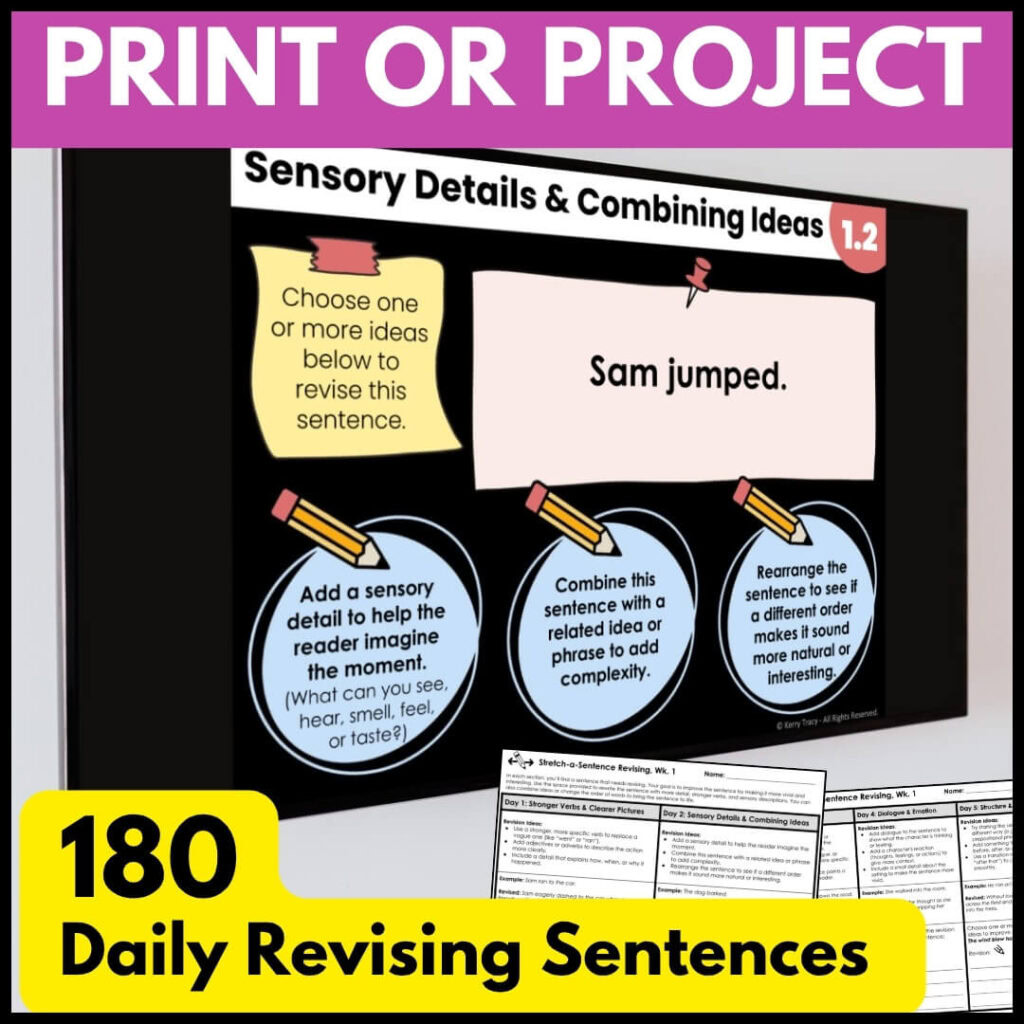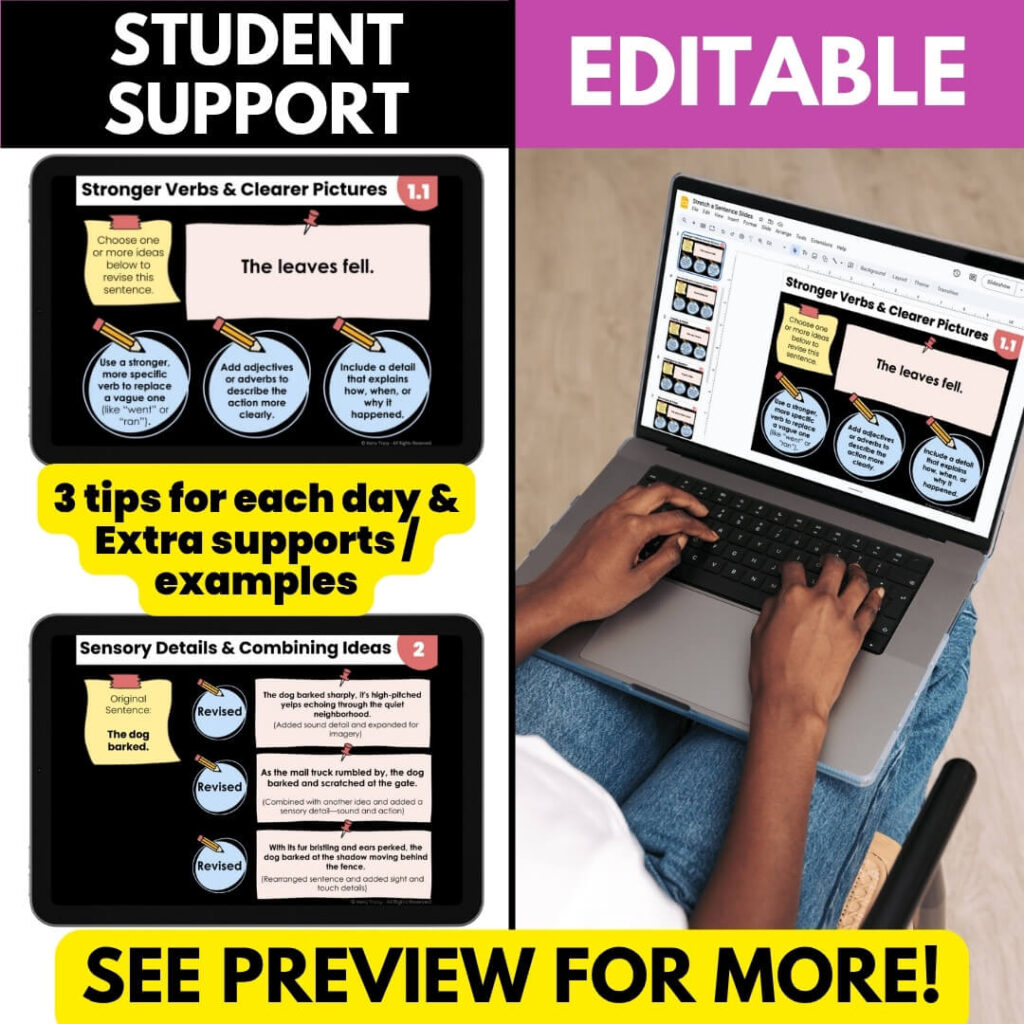When we introduce revising sentences and writing revision strategies in general, we often say “revise and edit” like they’re one step in the process. And let’s be honest: when time is tight, we treat them like one step. But here’s the problem:
When editing and revising are lumped together, revision almost always gets ignored.
Instead of thinking about how to strengthen their ideas, students start scanning for misspelled words and punctuation mistakes and call it good. The result? Their writing becomes grammatically cleaner, but conceptually flat.
The Problem Isn’t Motivation.
It’s Not Knowing How to Revise.
Most students want to do better. The issue is that many simply don’t understand how to revise a sentence in a meaningful way.
They don’t know how to make their writing more vivid, how to expand a sentence to show instead of tell, or how to vary sentence structure for better flow. So instead, they do what they do know: fix spelling, capitalization, and run a quick grammar check.
That’s why I suggest pulling sentence revision into its own separate lane in writing instruction.
And I’ve found that the easiest place to start?
One sentence at a time.
Revising vs. Editing: Why It Matters
What Students Don’t Understand About Revising Sentences
While most teachers know the difference, students often don’t, which is why it’s worth spotlighting the distinction between revising and editing.
Here’s a quick breakdown:
- Revising is about improving the content, clarity, and craft of writing. It’s where students focus on sentence revising like expanding ideas, adjusting tone, or restructuring for flow.
- Editing comes later and focuses on surface-level corrections like punctuation, spelling, and grammar.
When students blur the line between revising vs. editing, they often skip the deeper thinking that writing really needs. That’s why teaching revising sentences as its own step, especially through focused strategies for revising, is so powerful.
Why Teaching Sentence Revision Works Better Than Whole-Essay Revision
Benefits of Revising One Sentence at a Time
When you ask students to revise a full paragraph or essay, the task can feel overwhelming. It’s not just a writing challenge, it’s an endurance challenge.
That’s where sentence revising really shines.
Here’s why revising a single sentence at a time works so well:
✅ It’s bite-sized. Students can focus on improving ideas without the fatigue of tackling a full piece.
✅ It’s low-risk. They’re more willing to experiment when it’s just one sentence on the line.
✅ It’s transferable. Once students know how to revise one sentence, they naturally begin applying those skills to larger writing tasks.
✅ It’s efficient. In just a few minutes, you can introduce a strategy, model some revising examples, and let kids revise their own writing.
✅ It’s fun. If you give students a few minutes to share their sentence revisions, they’ll put more effort into trying to make their peers laugh or surprise them.
Teaching revising a sentence at a time builds the foundation for confident, skillful writers. Sentence revising helps students slow down and examine the choices they’re making, not just with grammar, but with word choice, structure, and clarity. When students get comfortable revising sentences on a small scale, they’re more likely to apply those lessons to longer drafts.
And the best part? Sentence revision improves overall writing quality! Even revising one sentence per paragraph in an essay or story can dramatically improve the overall impact of the writing. Students are more likely to actually do it (and to do it well) when it feels doable.
Sentence Revision Strategy:
Stretch a Sentence
One of the easiest and most effective strategies for revising is something I call Stretch a Sentence.
This approach focuses on taking a simple sentence and adding detail, variety, and voice to bring it to life. Whether students are working on narratives, informative writing, or even responses to text, expanding sentences helps them slow down and think about what they’re really trying to say.
Five Writing Revision Strategies to Teach
To make this even easier to implement, I created a classroom resource built around five key sentence revising strategies: one for each day of the week. Each day focuses on a different skill, like:
- Sharpening verbs
- Combining ideas
- Using figurative language
- Adding description
- Shifting sentence openings
Students use a tip sheet, analyze revising examples, and try their hand at revising their own work, all starting with just one sentence.
Whether you use it as a daily warm-up, a mini-lesson, a writing center, or a lead-in to narrative revision, this resource makes revision more manageable, more focused, and (dare I say?) more enjoyable.
And if you’re looking for a no-prep way to try it out with your students, I’ve got you covered:
👉 Check out the Stretch a Sentence Worksheets & Slides resource.
It even includes expanding sentences worksheets to help students apply what they’ve learned independently.
Final Thoughts on Teaching Sentence Revision
If you’ve ever wondered how to get students to move beyond surface-level edits, the answer is simple: start with sentence-level revision. Teaching students how to revise a sentence, one sentence at a time, makes writing feel manageable instead of overwhelming. It builds the habits they need to expand sentences, clarify ideas, and apply real writing revision strategies to longer drafts.
When revising vs. editing are separated, students finally see revision as creative thinking, not correction work. And with consistent practice using strategies like Stretch a Sentence, they begin making stronger choices with word choice, structure, and voice.
The more comfortable students get with revising sentences, the more they take ownership of their writing, and the better their paragraphs, essays, and stories become!
Sentence Revision FAQ
1. What is the best way to revise a sentence?
The best way to revise a sentence is to focus on improving clarity, detail, and flow, not just fixing grammar. Students can revise a sentence by sharpening verbs, adding sensory details, combining ideas, shifting the sentence opening, or using figurative language. Teaching one strategy at a time keeps sentence revision focused and manageable.
2. What is the difference between revising and editing?
Revising improves the content and craft of writing (things like clarity, structure, voice, and description). Editing focuses on mechanics such as spelling, punctuation, capitalization, and grammar. Students often confuse the two, which is why separating revising vs. editing is essential.
3. How do you teach sentence revision in elementary writing?
Start small. Model how to revise a single sentence using strategies like adding description, changing sentence openings, or expanding ideas. Show revising examples and then let students try revising one sentence at a time. This builds confidence before they tackle larger writing tasks like paragraphs or essays.
4. Why do students struggle with revising?
Most students aren’t avoiding revision, they simply don’t know how to revise. They default to editing because it feels easier and more concrete. Explicitly teaching strategies for revising sentences gives them the tools to improve their writing beyond surface-level changes.
5. How can students practice expanding sentences?
Students can practice expanding sentences through daily warm-ups, writing centers, or bell ringers focused on adding detail, combining short sentences, or shifting structure. Using expanding sentence worksheets or a routine like Stretch a Sentence helps them build these skills consistently.
6. What are some quick revising activities I can use in my classroom?
Try one-sentence revisions, revising a dull sentence, Glow & Grow peer feedback, remove-and-reflect activities, draft detective comparisons, or daily revision warm-ups. Any small, focused activity helps students internalize revision strategies without feeling overwhelmed.
Related Writing Posts:
- 5 Tips for Revising Persuasive Writing
- Writing Prompts that Inspire
- 8 Scary Fairy Tales Writing Lessons
- 7 Halloween Writing Activities
- Teaching Persuasive Writing Painlessly
Pin Me








